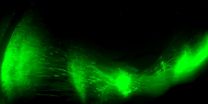(Press-News.org) NEW YORK, NY (September 10, 2015)--Researchers have discovered why long-term use of L-DOPA (levodopa), the most effective treatment for Parkinson's disease, commonly leads to a movement problem called dyskinesia, a side effect that can be as debilitating as Parkinson's disease itself.
Using a new method for manipulating neurons in a mouse model of Parkinson's, a Columbia University Medical Center (CUMC) research team found that dyskinesia arises when striatonigral neurons become less responsive to GABA, an inhibitory neurotransmitter. This suggests that it may be possible to modulate the activity of these neurons to prevent or delay this disabling side effect. The paper was published recently in the online edition of Neuron.
Parkinson's disease, a progressive neurodegenerative disorder, results from the death of cells in various parts of the brain, especially in a region called the substantia nigra. It is in the substantia nigra that a neurotransmitter called dopamine is formed, and when dopamine is lacking neurons fire abnormally, impairing one's ability to control movement.
"While Parkinson's is not curable, it is treatable with L-DOPA, which is converted into dopamine in the brain," said study leader David L. Sulzer, PhD, a professor of neurobiology in the Departments of Neurology, Psychiatry, and Pharmacology at CUMC and a research scientist at the New York State Psychiatric Institute. "However, while taking L-DOPA helps patients move normally, in many individuals it eventually triggers uncontrolled excessive movements." Parkinson's is estimated to affect about one million people in the U.S. and up to 10 million worldwide.
Most studies into the cause of dyskinesia in Parkinson's have focused on the dopamine receptors that remain in the brain, which over time become over-reactive to L-DOPA therapy. However, the CUMC team decided to look at how neurons of the basal ganglia regulates movement in the absence of dopamine.
"Dopamine neurons modulate the basal ganglia," explained lead author Anders Borgkvist, PhD, a postdoctoral fellow in Dr. Sulzer's laboratory. "And because that circuit is still running in patients with Parkinson's, it's long been suspected that other parts of the circuit behave abnormally in this disease."
However, scientists lacked a way to stimulate selective parts of the basal ganglia to evaluate what was happening when dopamine is no longer available. The CUMC team employed a novel form of optogenetics, a technique that uses light to control neurons that have been genetically sensitized to light, and found that after long-term dopamine loss, striatonigral neurons lose their ability to respond to the neurotransmitter GABA (gamma-aminobutyric acid). This effect was not found with short-term dopamine loss.
"When striatonigral neurons are working normally, they act as a brake on the basal ganglia, in effect shutting down unwanted movement," said Dr. Sulzer. "But when there is dopamine loss, as in Parkinson's, striatonigral neurons try to compensate, and eventually lose their responsiveness to GABA. Our hypothesis is that when L-DOPA is added into the system, you lose the ability to filter, or turn off, unwanted movement."
"Our findings suggest that GABA and GABA receptors are still present in the striatonigral neurons," said Dr. Borgkvist. "So then the question becomes, why they aren't functional? I think that we, or another lab, will eventually find the answer. In any case, the implication is that this defect is correctable, and that would mean that we could prevent or at least delay dyskinesia, so that patients could continue to use L-DOPA."
"Patients do not develop dyskinesias in the early stages of Parkinson's, but only after several years of the disease," said Stanley Fahn, MD, the H. Houston Merritt Professor of Neurology and emeritus director of the Parkinson's Disease Foundation Research Center at CUMC. "A major reason why these patients want to delay the initiation of L-DOPA therapy is to avoid these dyskinesias for as long as possible. These new findings open up possible ways to treat or prevent the dyskinesias. If such treatments were found, patients would probably seek to be treated early and improve their quality of life sooner."
Dr. Sulzer believes it is likely that scientists will identify other mechanisms, in addition to striatonigral neurons, that contribute to Parkinson's-related dyskinesia.
INFORMATION:
The paper is titled, "Loss of Striatonigral GABAergic Presynaptic Inhibition Enables Motor Sensitization in Parkinsonian Mice." The other contributors are: Anders Borgkvist, Elizabeth M. Avegno, Minerva Y. Wong, Mazen A. Kheirbek, Mark S. Sonders, and Rene Hen (all at CUMC).
The authors declare no financial or other conflicts of interest.
This work was supported by grants from the JPB Foundation and Parkinson's Disease Foundation, the National Institutes of Health (NIDA10154), and the Udall Center of Excellence for Parkinson's Disease research in the Department of Neurology at Columbia University.
Columbia University Medical Center provides international leadership in basic, preclinical, and clinical research; medical and health sciences education; and patient care. The medical center trains future leaders and includes the dedicated work of many physicians, scientists, public health professionals, dentists, and nurses at the College of Physicians and Surgeons, the Mailman School of Public Health, the College of Dental Medicine, the School of Nursing, the biomedical departments of the Graduate School of Arts and Sciences, and allied research centers and institutions. Columbia University Medical Center is home to the largest medical research enterprise in New York City and State and one of the largest faculty medical practices in the Northeast. For more information, visit cumc.columbia.edu or columbiadoctors.org.
Alexandria, VA - The American Geosciences Institute's (AGI) is pleased to announce the release of a community consensus statement on access and inclusion of geoscientists with disabilities. This statement was inspired by the 2014 AGI Leadership Forum, which brought together the Executive Directors and Presidents of AGI's Member Societies to discuss the issue of access and inclusion of persons with disabilities in the geosciences.
The meeting was facilitated by the Executive Director of the International Association for Geoscience Diversity (IAGD) Christopher Atchison, ...
NASA's RapidScat instrument analyzed the sustained surface winds of Tropical Storm Henri on Sept. 8 as the storm was intensifying.
When the International Space Station flew over Tropical Depression 8 in the Eastern Atlantic Ocean on September 8 at 1p.m. EDT, NASA's RapidScat instrument aboard captured data on the storm's surface winds. RapidScat showed that there were tropical-storm-force winds north and east of the center near 27 meters per second (60.4 mph/97.2 kph). However, sustained winds on the west and southwestern quadrants were near 12 meters per second (26.8 ...
September 10, 2015 (Washington) - There are substantial differences among Americans when it comes to knowledge and understanding of science topics, especially by educational levels as well as by gender, age, race and ethnicity, according to a new Pew Research Center report.
The representative survey of more than 3,200 U.S. adults finds that, on the 12 multiple-choice questions asked, Americans gave more correct than incorrect answers. The median was eight correct answers out of 12 (mean 7.9). Some 27% answered eight or nine questions correctly, while another 26% answered ...
DOWNERS GROVE, Ill.-- September 10, 2015--Having patients lie on their left side while the right side of their colon is being examined can result in more polyps being found, thus increasing the effectiveness of colonoscopy for colorectal cancer (CRC) screening, according to a study in the September issue of GIE: Gastrointestinal Endoscopy, the monthly peer-reviewed scientific journal of the American Society for Gastrointestinal Endoscopy (ASGE).
CRC is one of the most common cancers in the US and other western countries. Studies have shown that deaths from CRC are reduced ...
Two recently published studies in the journals Age and the British Journal of Nutrition (BJN) demonstrate that consuming cocoa flavanols improves cardiovascular function and lessens the burden on the heart that comes with the ageing and stiffening of arteries. The studies also provide novel data to indicate that intake of cocoa flavanols reduces the risk of developing cardiovascular disease (CVD).
As we age, our blood vessels become less flexible and less able to expand to let blood flow and circulate normally, and the risk of hypertension also increases. Arterial stiffness ...
This news release is available in German. Protein labeling with synthetic fluorescent probes is a key technology in chemical biology and biomedical research. The target proximity achieved by small-molecule probes is essential to exploit the full potential of super-resolution fluorescence microscopy. Single-molecule localization techniques provide high spatial resolution by reporting on the position of the fluorophore and thus only indirectly on the target molecule itself. Large labels, such as antibodies, can misleadingly position a fluorophore tens of nanometers away ...
An international research team, which includes NYU anthropologists Scott Williams and Myra Laird, has discovered a new species of a human relative. Homo naledi, uncovered in a cave outside of Johannesburg, South Africa, sheds light on the diversity of our genus and possibly its origin.
"This discovery is unprecedented in the sheer number of hominins collected from such a small area in the virtual absence of other animal remains," says Williams, an assistant professor in NYU's Department of Anthropology. "That makes this site unique. Moreover, the announcement describes ...
Bethesda, MD (Sept. 10, 2015) -- Detection of small fragments of tumor DNA, known as circulating tumor DNA, in a patient's pre-surgery serum samples predicts early recurrence of hepatocellular carcinoma and may guide treatment, according to a study1 published in Cellular and Molecular Gastroenterology and Hepatology, the basic and translational science journal of the American Gastroenterological Association. Hepatocellular carcinoma -- the most common type of liver cancer -- is the third leading cause of cancer deaths worldwide.
"We uncovered that circulating tumor DNA ...
The steps involved in evaluating and diagnosing patients with epilepsy are complicated. In a new and extensive literature review of available information, experts provide insights on the valuable role of genetic testing in the diagnosis and care of pediatric epilepsy.
Epilepsy is a common neurological disorder that affects up to 1.5% of the world's population and is more commonly diagnosed in children than adults. Most cases of epilepsy have been considered "idiopathic" or of unknown cause, but recent advances in genetic testing are providing insights on the potential ...
In a modern, multicore chip, every core -- or processor -- has its own small memory cache, where it stores frequently used data. But the chip also has a larger, shared cache, which all the cores can access.
If one core tries to update data in the shared cache, other cores working on the same data need to know. So the shared cache keeps a directory of which cores have copies of which data.
That directory takes up a significant chunk of memory: In a 64-core chip, it might be 12 percent of the shared cache. And that percentage will only increase with the core count. Envisioned ...


